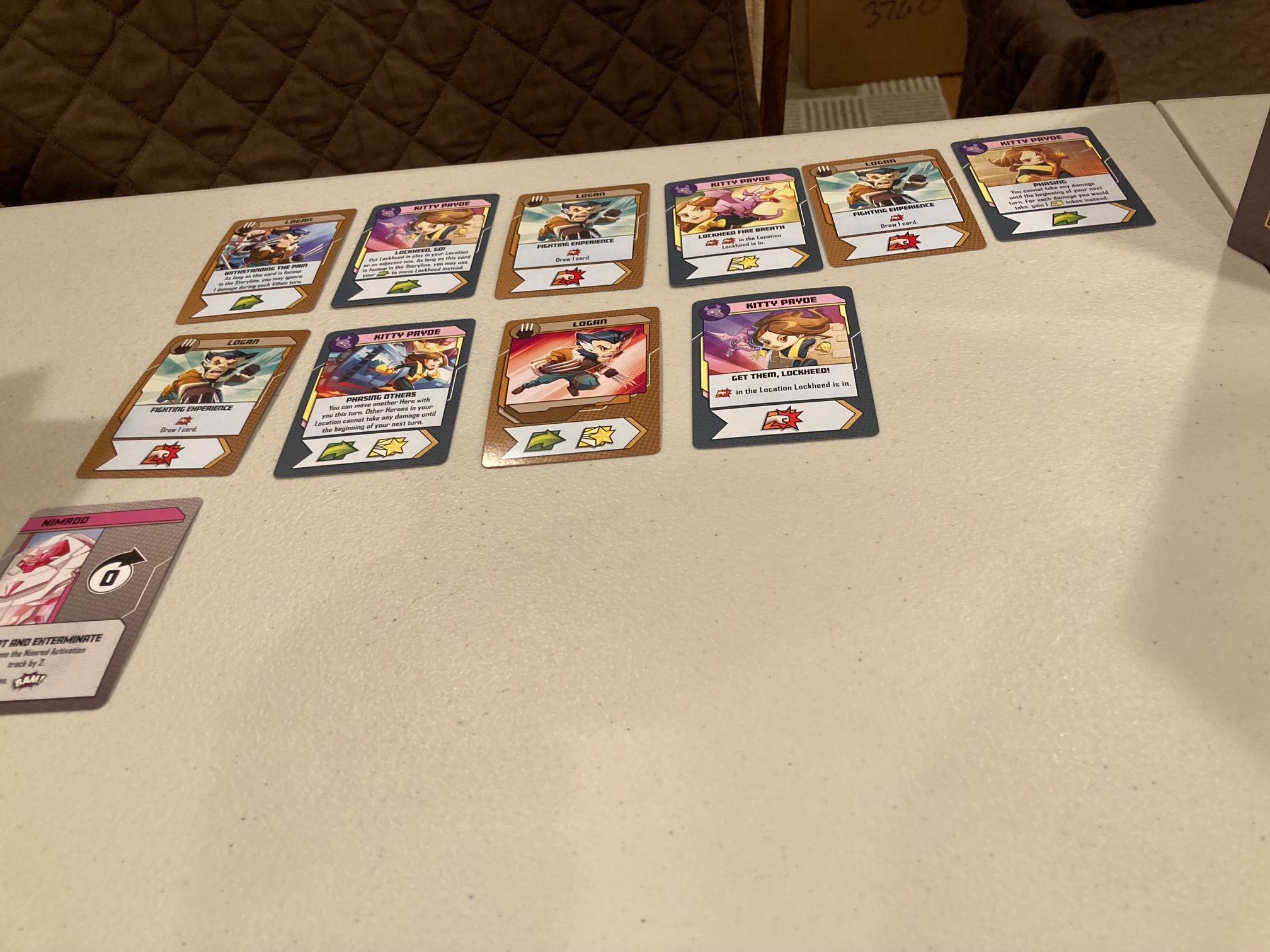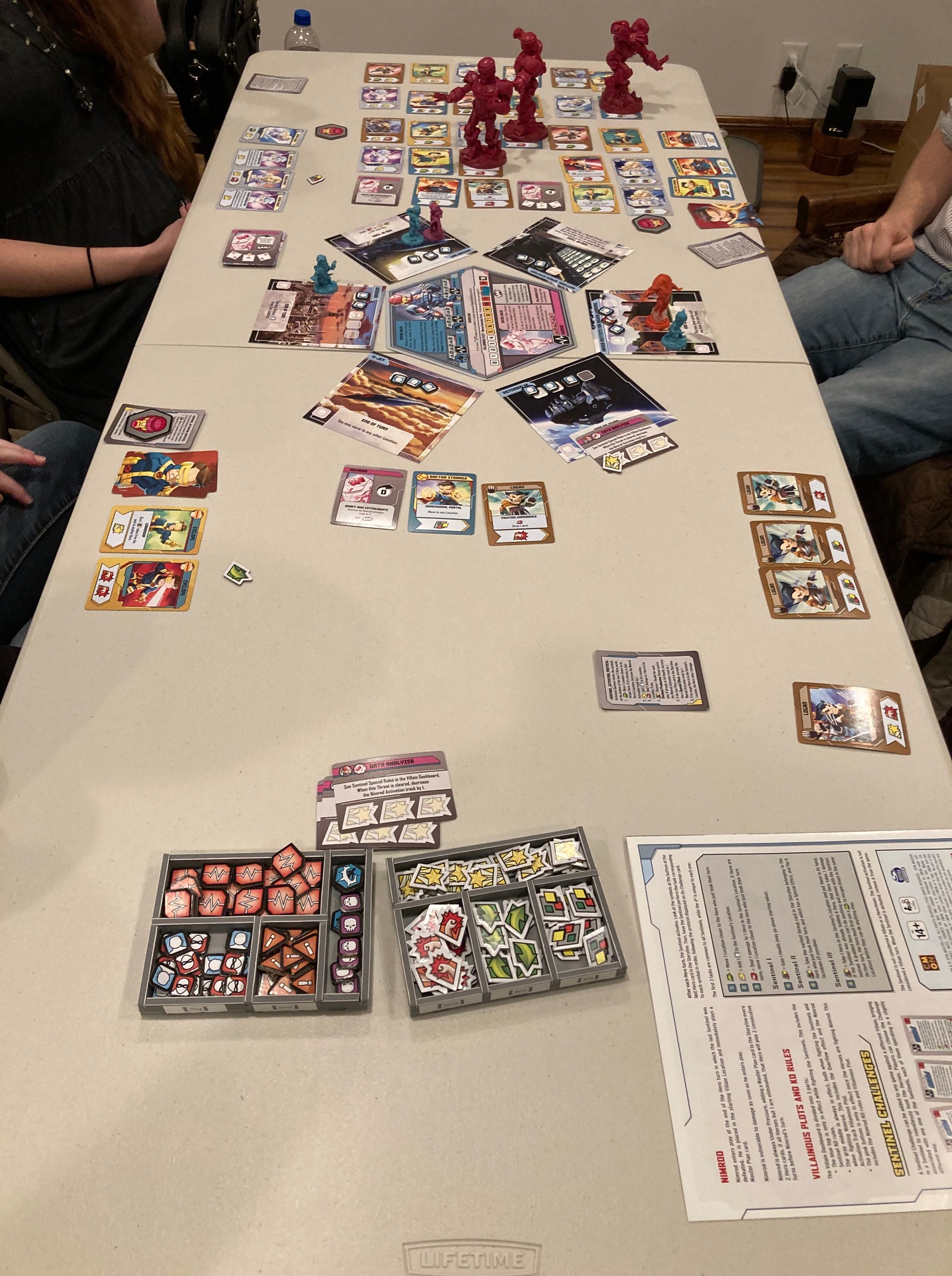Paint The Roses is a light cooperative deduction game for 2-4 players. This was on Kickstarter back in November 2021. They promised delivery in April 2022, and you know what? They almost made it! I think I got my copy a few weeks ago in early May 2022. Given how many Kickstarters miss their delivery dates by months and years, I am going to count this as a win! Good job Northstar games!
Paint The Roses is a tile-laying game set in the world of Alice in Wonderland. We are seeing a lot of these lately: there was Wonderland’s War, and the cooperative Dice Placement game Automated Alice which we liked (see review here), and some others on Kickstarter.
Unboxing

This is the deluxe version of the game with plastic tiles.

The little plastic tiles are super nice. See below.

Each tile has a color (rose color) and shape (heart, diamond, club, spade). This two pieces are what players will be matching/guessing.

The little plastic container contains both the tiles and some minis (!) and clue tokens.

The red queen chases us around the board trying to chop our heads off. The bunny represents points in the game where the queen accelerates. We (as a group) are the little painter.

The queen “chases us” around the board (see above). Whenever we pass the the bunny, the queen speeds up and adds a rose (which increases her speed by one!).
If the queen ever catches us, we lose.

We win if we fill the garden with roses without dying. See above for a full garden!

During a turn, we get to choose one tile: the 4 choices are placed in the offering.
The board is truly nice, with indents to place the tiles (see above).

Below the tray and boards are a bunch of cards and pads.

Most of the cards above are expansions.

The other main cards are the “queen’s whim” cards. See above.

The cards are all nice and linen-coated (see some of the reflection above on the whim cards).

SInce this is a deduction game, the game also gives you some pads to take notes with. See above with more whim cards.

Overall, the component quality is very high, and this looks good on the table.
Rulebook

Well, there’s sort of two rulebooks. There’s the base rulebook (above) and the expansions rulebook (below).

We’ll come back to the expansions later.
The base rulebooks is fine: it does what we expect, components, set-up, how to play pretty nicely.





Overall, I had no trouble learning the game form the rulebook.

The rulebook evens ends with a player’s aid. Yay! The game doesn’t have a summary sheet per se, so this back of the rulebook was nice.
Basic Gameplay

The premise is that players are gardeners and must paint the roses in the garden to match the mad queen’s whims! Each player has a secret “whim” card which represents one thing the queen wants in her garden! But players (as fellow gardeners) can only obliquely communicate, lest they anger the queen!

See above for a whim: the queen has told me she wants to put a red rose next to a red rose!
This is a limited communication game: each player can only communicate by putting out their tiles and then putting clues down. The choice of tile and number of clues are the ONLY pieces of information that a player can communicate on their turn!

After putting down my red rose tile (see above) and putting my purple clues out, the other players guess what the whim was. The number of clues tell you how many things you matched on the tiles around you. (I made an error: there should only be 1 clue above, as there was only one red rose adjacent to the tile I put out). After that, the players try and guess what the whim was! In this case, if the players guess red rose/red rose, we get 3 victory points!
Solo Play

There is no solo play in this game (in spite of Saunders’ Law). To be fair, since this is a hidden information game (with the whims hidden), it’s hard to make a solo game. We did try the Changing Perspective’s Idea (see here for more discussion) and it kinda worked. I played solo as a two-player game, keeping two whims. The two player mode has a few changes (see below).

Using “only the information on the board”, I alternated between players, trying to guess what the current player’s whim was. This means I have to “pretend” I don’t know what the whim is and ONLY USE THE INFORMATION ON THE BOARD. The problem is, this becomes very mechanical and you have to calculate the odds quite a bit: “In this configuration, there is a 1 in 3 chance I can guess the whim: each of the three possibilities is likely!” So, I’d pull out a dice and roll: a 1-2 is option 1, 3-4 is option 2, and 5-6 is option 3. If the odds were ever better than 50% for possibility, I would just guess the more likely outcome. 50% or under, I’d calculate the odds and roll a 6-sided die. (Note: no die is included with the game).

Unless you really like computing the odds yourself and rolling, you probably wouldn’t like this way of playing. I could see this as being a good way to teach “how to compute odds” (for younger kids), or at least practice “computing odds”, but I suspect most most people wouldn’t really enjoy this way of playing.
Anyways, this game doesn’t come with a solo mode. This was just me trying something to learn the game so I could teach my friends.
Cooperative Play

The game works much better as a cooperative game! At 3 and 4 players, the game really does seem to work well! I struggled a little with the 2-Player game (because it has weird rules to try to scale it back), but it worked ok. I think this game is probably best at 3 or 4 players.
Most games start with just trying to guess from the basic clues given, then more and more negative information tends to sway the players.

Negative and Positive Information

It’s very easy to play this as a light game: “Oh these are my clues, here’s what I guess!” … and make it a light simple game. You can also make it as complicated as you want by noticing both negative information and positive information! By positive information, I mean “what information is gleaned from a tile choice/tile placement”: the direct information that follows from that choice. By negative information, I mean the “indirect information that is gleaned from tiles not chosen and tiles not placed”. If a player does not play a tile, that can be as much information as the tile the player chose!

Or, where does a player play a tile? If they had played a tile in one place it’s telling, but they played ELSEWHERE, it would have been more telling, so they must have the other one! This game can be a deeper deduction game if you want … or not. If the group you are with really wants to “go down the rabbit hole” (ugh, did I really just make that joke) of noticing which tiles/spaces weren’t played, this game can become much deeper.
The game lasts about 20-35 minutes: 20 minutes if you play light, 35 minutes if you play deep.
Expansions

So, this game comes with 9 (10 if include the Caterpiller expansion from the Kickstarter) expansions! I’ll be honest, I think this is a little ridiculous. Paint The Roses is a very simple deduction game that sings because of its simplicity. These expansions are all over the over place from different designers (some big names too) and they change up this game in different ways, but just a little.

I tried a couple, they were ok. They added a little more randomness, but they added some fun new cards. I mean, we liked the expansions ok.
In the end, If Paint The Roses were my favorite game, I can see enjoying the expansions as a way to add life to the game. Or, this could be a good game for a couple: they can go through the whole game over a few months, with each expansion bringing new life! Theses expansions provide a conduit to play new content in a familiar environment.
In the end, I think most people will probably ignore the expansions and just play the base game. But maybe I’m wrong.
Conclusion

Paint The Roses is a nice cooperative deduction game with beautiful components that I can recommend. It’s not great, but it’s very enjoyable. It’s easy to bring this out if you just want a simple 20 minute game. It’s also easy to bring this out as a more complex game (35 minutes) for game groups that wants to follow up on both positive and negative information.
If you find you love the game, you’ll find there are many many expansions that come with the game, but I don’t see most people playing them: they will probably only be for people who resonate deeply with the game.























































































